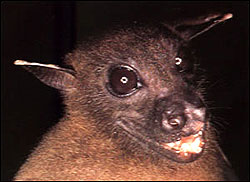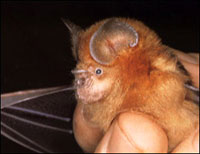The secret life of bats
By Phil Richardson
Bat senses
Bats are active mainly at night and their senses reflect this. They have an array of senses that they use to determine where they are going, to avoid obstacles, find food and mates, return to their roosts, and so on. As well as the familiar ones of vision, smell and hearing, these include the remarkable sense of echolocation, developed in the microbats for finding their way about and hunting insects in the darkness of night.
Sight

Large, light-gathering eyes help this megabat, Dobsonia inermis, to see in dark conditions. The long snout helps it to smell fruit from some distance. (Image: Phil Richardson)
Old World fruit bats have relatively large eyes with good light-gathering capacity. They need to be able to see where they are and to avoid obstacles when flying across a landscape, and to see where the trees are that hold their fruit and where they can perch safely when eating it.
Insect-eating bats, on the other hand, have small eyes, as they use the special sense of echolocation for finding their food. However, they still use their eyesight for avoiding large objects, gauging their height above the ground and finding their way across a landscape by navigating between prominent landmarks. Although not as well developed as a fruit bat's eyesight, their vision is particularly sensitive to low light conditions.
Even on the darkest night there is some light around and all bats use this. Old World fruit bats have colour vision, which is useful to them as they are often quite active in daytime, roosting on trees in exposed positions, rather than tucked away in dark crevices like most microbats, which can see only in black-and-white.
Olfaction: the sense of smell

A headful of senses on a microbat - Schneider's leaf-nosed bat, Hipposideros speoris. The small eyes are typical of the microbats. The large ears and complex nose leaf are linked to echolocation. Touch-sensitive hairs can be seen around the face. (Image: Phil Richardson)
All bats have a good sense of smell. Old World fruit bats rely on it greatly to find their food supplies, and their long muzzles are packed with smell-sensors. They are able to detect the smell of rotting fruit or the scent of a flower downwind over a considerable distance. Bats also use smell to identify their own youngsters from a crèche of apparently identical babies, often in pitch-black conditions. They have scent glands that they use to mark themselves and other members of their colony, and probably also their roosting sites. Many of these scents are odourless to us, with our poor sense of smell, although some bats have a musky smell that we can detect.
Echolocation and hearing
Echolocation is a type of sonar that microbats use to detect prey, locate roosting crevices and avoid close obstacles in the dark. These bats emit a very loud and short 'shout' of sound and listen for the echo that bounces back when it hits an object. Put simply, this can tell the bats how far away the object is by estimating the time it takes before they hear the echo. The longer it takes the echo to return, the further away the object.
Bat detectors
Bat calls are of a frequency too high for us to hear, but the electronics of a bat detector machine can convert the sounds so we can hear them.
The calls vary in repetition rate, intensity, frequency and length.
As with bird song, it takes some practice to be able to distinguish the more similar species, but bat detectors are now one of the main tools of bat researchers. They are useful for obtaining accurate counts of bats emerging from a roost: the failing light means that some bats can be missed visually, but every bat calls as it emerges and so can be heard as well as seen. When bats are approaching an insect they speed up their echolocation pulses, culminating in a trill or buzz.
These can be heard on the detector and give an indication of the success rate of feeding.
Although there may only be a fraction of a second's delay between shouting and hearing the echo, bats have the mental equipment to process the information. A hard-bodied insect produces a different quality of echo from one with a soft body, so bats can distinguish between some different groups of insects in this way. They can also determine the size of the object.
To gain maximum information, the bats usually shout out very high-frequency sounds, usually between 20 and 200 kHz. (Humans can hear only up to 20 kHz; a dog-whistle is about 25 kHz.) High-frequency sounds have short wavelengths, which give a far more detailed echo, rather like the detail on a painting produced with a fine paintbrush compared with one done using a huge decorator's brush. Bats gain even more information by giving out shouts that vary in frequency, starting off very high and sweeping down to a lower frequency.
These echolocation pulses last only a few thousandths of a second and bats emit perhaps 10 or 15 calls each second. The silences between enable them to listen in to the echo information coming back. Their specially evolved brains enable them to build up an amazingly accurate picture of objects close to them. From the variable echoes produced, they can work out the size and hardness of the body of the insect. A bat can also discern the flutter of the prey's wings, and there is evidence that some bats can compute their flight speed compared to objects around them by using Doppler shift. This is the change in pitch of sound produced by a moving object. We hear, for example, the higher-pitched sound as a high-speed train approaches our platform (the approaching sound waves are compressed) and then we can detect the lowering in pitch as the train passes and races away from us (the sound waves are now stretched).
Using all this information means that a bat can identify and locate its prey from a distance and then attack. As it flies closer, it speeds up the echolocation calls until just before contact, when they are so fast they become like a continuous trill or buzz. The information is constantly fed back to take into account any changes in direction of the prey. Experiments have shown that bats could avoid wires as fine as human hairs stretched across their flight path in pitch-black rooms.
For echolocation to work most bats have to really bellow the sound out--after all, they are trying to hear the echo bouncing back from a relatively tiny, fairly soft object. Some bats produce sounds louder than 110 decibels, the same volume as a jet plane flying low overhead. To cope with this, they have a special muscle that closes off the inside of the ear when they shout, so that they are not deafened. Fortunately, the high-frequency sounds used, although very loud, are above our sense of hearing. Bats obtain most of the energy to produce their bursts of sound 'for free' because they link their shouts to their wing-beats: they exhale and shout on every wing-stroke.
A limitation of echolocation is likely to be the range at which it can operate. High frequencies have a short range of about 6m at the most for a small bat that shouts loudly, and perhaps less than 3m when a small insect is to be detected. If bats were to use low-frequency sounds instead, then the range would be much greater, but the detail would be lost.
Some bats emit these sounds not through their mouths, but via their specially modified nostrils, using strange folds of skin around the nose to direct the sound waves--like people cupping their hands around their mouth before shouting.
Fruit bats of the Old World do not normally need to echolocate, because they use their keen sense of smell to locate their food, but a few, such as Rousettus, roost in caves and so need to find their way about in the dark. They give out a series of clicks with their tongues and echolocate as the sounds bounce back from the cave walls.
The hearing of bats is very sensitive to the faint, high-frequency echoes that are reflected back from tiny insects. Even the chatter bats make in roosts, which is audible to humans, has a great deal of high-frequency sound (or ultrasound) in it that we cannot hear. Lower-pitched sounds that we can hear would be inaudible or barely audible to bats. Some bats find their food by listening to the slight sounds the prey makes - the rustle of a scorpion moving across sand, the whisper of a moth's wings or the movement of a leaf caused by a passing spider.
Many bats have large ears so as to gather as much sound as possible. Generally, the bigger the ears, the quieter are the bats' echolocation calls. Many insectivorous bats have an extra spike of cartilage (called a tragus) sticking up from the base of each ear and researchers think that this helps to give better sound definition in a particular plane, although, as with so many aspects of the study of bats, its precise function is unknown. It is certainly a useful feature for bat researchers. Different species of bats have a differently shaped tragus, so its appearance can be used to identify species.
Toolbox

There are 27 km of specimen shelves in the Darwin Centre - the same distance as between the Museum and Junction 6 of the M1.